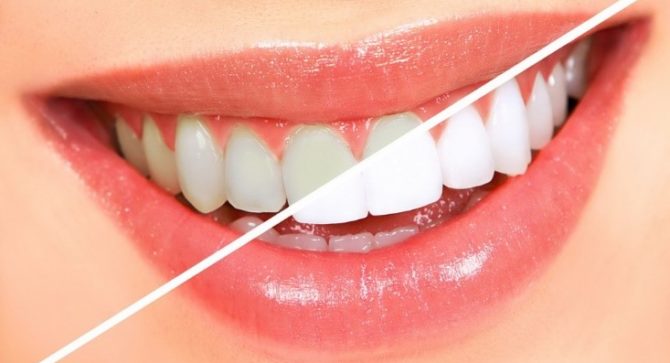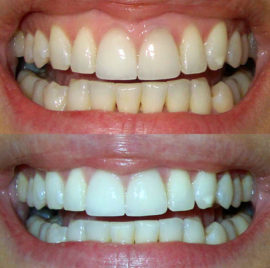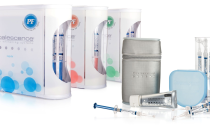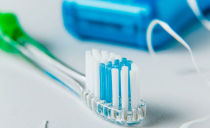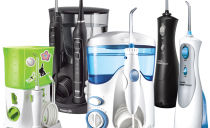Professional and independent teeth whitening
A beautiful snow-white smile always decorates, so many decide to lighten tooth enamel. The teeth whitening procedure is performed by a professional in the dental office, but you can also try home methods that often turn out to be no less effective. but preference should be given to those methods that do not harm tooth enamel and health.
Content
The main indications for whitening
Usually enamel is clarified with only one purpose - to give it an aesthetic appearance. Yellow teeth with plaque cause discomfort, a person with an ugly smile may appear complexes that prevent full communication with people.
Sometimes doctors recommend a bleaching procedure. For example, in cases where the client needs restoration or prosthetics. Thanks to the preliminary cleaning of the tooth surface from deposits and stones, the dentist will be able to choose the optimal color of the crown or fillings. Seals installed after the completion of professional cleaning are longer and less trouble.
Teeth preparation for whitening
Whitening is carried out only on healthy teeth.Therefore, it is necessary to first cure gum disease, pulpitis, fluorosis, periodontitis, caries and other diseases.
Thin and crack prone enamel is recommended to remineralize. For this, the doctor will apply a special substance containing fluorine or phosphorus, calcium. These drugs help strengthen dentin and improve dental health.
Professional whitening
If you look at the photo where the teeth are shown before and after bleaching in a dental clinic, it becomes clear that going to a specialist gives a guaranteed result. A professional enamel clarification procedure involves exposure to dentin with special active agents, due to which the teeth become lighter up to 12 tones.
The procedure for teeth whitening at the dentist most often occurs in several stages:
- Application of special professional bleaches.
- Strengthening the activity of the applied composition by heating the surface of the tooth with a laser or a special lamp.
- Rinse the reagent with water.
- Coating the dentition with a protective fluorine-containing varnish.
The duration of professional whitening is from 30 minutes to 2 hours, that is, the effect will be achieved in just one session with the dentist.
Types of teeth whitening in dentistry
- Laser Using a laser, you can lighten the tooth enamel to a pre-selected color by the doctor.
- Chemical. Chemical whitening involves the use of special pastes with a pronounced abrasive effect.
- Mechanical Lightening by brushing your teeth. For this, different methods are used: ultrasound, toothpaste, pharmacy preparations based on activated carbon, powders and more. This method helps if a dark coating on the enamel appears from the frequent use of caffeinated drinks, smoking, after prolonged wearing of braces.
- End bleaching. The method consists in cleaning the mouth of the root canals of the old fillings and applying the whitening gel to the crown.It is used for teeth with a removed root and sealed root canals, as well as if several external clarification procedures have been unsuccessful.
- Photo whitening. A special gel containing hydrogen peroxide is applied to the enamel. Then they shine on this gel with a halogen lamp, due to which active oxygen is released, which pushes pigments out of the tooth and discolors them. From time to time the procedure has to be repeated.
Enamel brightening at home
At home, special pencils, strips, pastes, which are sold in pharmacies and ordinary stores, are used to whiten teeth. Some of them are quite effective. If you use such funds for a long time, you can get rid of yellow plaque, and sometimes lighten your teeth in a couple of shades.
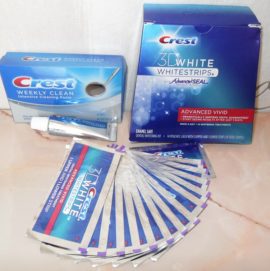 For instance, with the help of whitening strips you can make your smile snow-white in just 2-3 weeks, the effect will be fixed for 3-4 months. Tooth pencil is an analogue of clarifying gel. Its advantage is the convenience of applying the active substance to problem areas. Whitening paste will be effective only if the person has correctly selected a toothbrush and brushed his teeth for a long time.
For instance, with the help of whitening strips you can make your smile snow-white in just 2-3 weeks, the effect will be fixed for 3-4 months. Tooth pencil is an analogue of clarifying gel. Its advantage is the convenience of applying the active substance to problem areas. Whitening paste will be effective only if the person has correctly selected a toothbrush and brushed his teeth for a long time.
Use means available to the simple consumer with caution. Teeth whitening at home often leads to the appearance of increased sensitivity of the gums.
You should not expect a quick result from such manipulations; you can whiten the tooth surface on your own in one day only with the help of preparations, the components of which do not clean, but paint the enamel white.
The most popular and safest way to whiten teeth at home is to use baking soda. You just need to add sodium bicarbonate to the toothpaste, apply it to an ordinary toothbrush and clean the enamel.
Fairly well remove plaque in hard-to-reach places of ash and activated carbon. But with the help of these products you can achieve a minimal whitening effect: in a few months of their regular use, the enamel will become lighter by just a couple of tones.
The use of silicone mouthguards
Of particular note is the teeth whitening procedure using silicone mouthguards. This process is carried out in several stages:
- Dentist taking an impression of the oral cavity.
- Production in the laboratory of individual silicone caps.
- Filling the mouth guard with a special gel. Unlike concentrated professional products, gels with a low acid concentration are used at home.
- Use by the patient of the prepared design according to a special scheme. Kappa is worn every day, guided by the instructions and gradually increasing the wearing time.
- At the end of the treatment session, the oral cavity is cleaned of the remnants of the gel and rinsed thoroughly.
The condition of tooth enamel will become noticeably better within a week after the start of wearing a mouth guard, but a course lasting 25-30 days is required to obtain a snow-white smile.
Features of bleaching procedures at home
There are some nuances that must be considered when self-clarifying tooth enamel:
-
If in any good clinic in Moscow bleaching can be done in one visit to a doctor, then at home it will take much more time: several weeks or even months.
- All manipulations will have to be done on their own, but this is not so simple. For household use, the use of less aggressive materials is recommended: the same gel should be at least 2-3 times less concentrated than professional. And still, before applying the product, you need to make sure that the active substance does not fall on the gums, as it can damage the mucous membranes.
- Before the procedure, a specialist consultation is required.Only a doctor will be able to adequately assess the extent of the problem and choose an effective remedy. All actions before and after teeth whitening should be carried out under the constant supervision of a dentist.
Result fixing
The teeth whitening procedure is carried out at intervals of 6 months to 2 years. To reduce the number of sessions, all preventive measures recommended by the dentist should be carried out.
To maintain the whiteness of tooth enamel after the completion of the whitening procedure, you can use:
- the use of high-quality and effective toothpastes that are designed to care for the entire oral cavity;
- elimination of dental deposits in the clinic several times a year (preferably every 4 months);
- limited use of products that include coloring pigments: strong tea, black coffee;
- quitting smoking cigars, cigarettes, hookah.
Probable complications
Most often, negative consequences occur after home whitening. Most people in pursuit of a beautiful Hollywood smile do not adhere to the recommendations on the use of certain means - and their teeth become uneven in color.
Another reason for which dental consultation is required before lightening tooth enamel is the presence of fillings. Only a doctor can predict the reaction of a filling to a bleaching gel reagent and, taking this into account, correctly select a drug. Otherwise, the material can darken, which will ruin the appearance of the enamel.
It is worth mentioning in the article that active components of bleaching agents can burn the mucous membrane. The likelihood of an allergic reaction, increased sensitivity of the gums, and other unpleasant sensations is not excluded.
Usually, all pathological manifestations go away on their own after a few days. If this does not happen, you should consult a doctor as soon as possible.
Contraindications
It is not recommended to whiten teeth:
- children and adolescents under 18 years of age;
- pregnant women and mothers during lactation;
- persons with cancer;
- patients with diabetes;
- while taking potent drugs;
- in the presence of crowns or a large number of fillings on the outside of the dentition;
- if there is carious damage to the enamel or problems with the gums;
- people allergic to citric acid, baking soda, hydrogen peroxide, other bleaching substances.
Teeth whitening is not a harmless procedure. It should be approached with utmost care and responsibility. And it is best to entrust this process to a good specialist.

